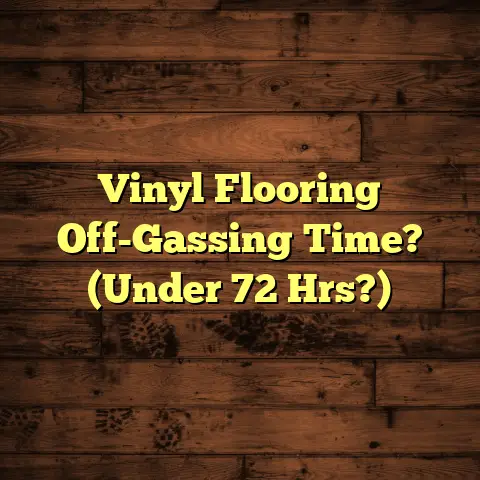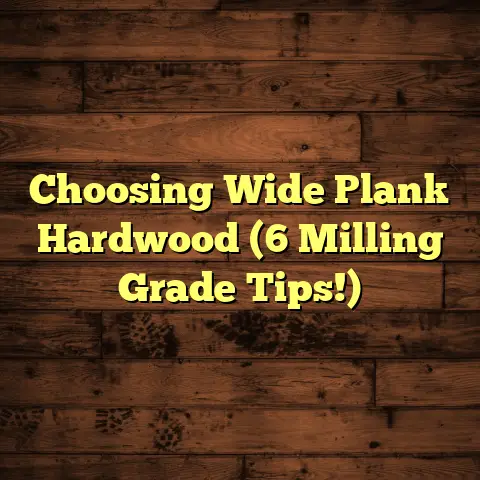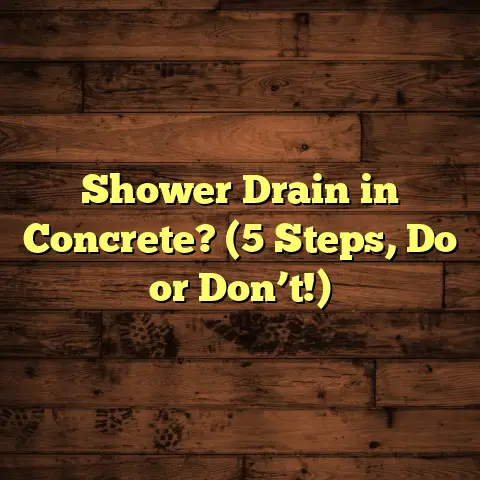Clean Unfinished Wood Floors? (5 Top Scrubbing Don’ts!)
And let me tell you, unfinished wood floors are a whole different ballgame.
They’re beautiful, rustic, and full of character, but
they demand respect.
Today, we’re diving deep into the
world of unfinished wood floor care, specifically the
“don’ts” that can save you a lot of heartache (and money!).
Introduction: Why Location Matters
Before we get into the nitty-gritty, let’s talk about location, location, location.
Where you live plays a HUGE role in how your unfinished wood floors behave and what they need.
Think about it: a cabin in the humid mountains of North Carolina is going to face different challenges than a loft in the arid Arizona desert.
Humidity Levels: High humidity is a breeding
ground for mold and mildew.
Unfinished wood, being
porous, soaks up that moisture like a sponge, leading to
warping and even rot.
I’ve seen floors in coastal areas
swell so much that they buckle!
On the flip side, dry climates can cause wood to
shrink, crack, and splinter.
Imagine walking barefoot
and getting a sliver – not fun!
According to the EPA, ideal indoor humidity should be between 30-50%.
Climate Variability: Seasonal changes are another
factor.
In regions with harsh winters and hot summers,
wood floors constantly expand and contract.
This puts
stress on the wood and any finish (or lack thereof), making
careful cleaning practices even more critical.
Regional Materials: The type of wood used in your
floors matters too.
Pine, a softer wood, is common in
older homes in the Southeast.
Oak is a durable hardwood
found across the country.
Each species has its own
porosity and reacts differently to cleaning products.
Lifestyle Considerations: Do you have kids?
Pets?
Live near the beach?
These all impact the type and
amount of dirt that ends up on your floors.
A family
with muddy dogs tracking in dirt every day needs a
different cleaning strategy than a single person in a
city apartment.
I’ve worked with families who love hiking and
mountain biking, and their unfinished wood floors were
constantly covered in mud and grime.
It was a constant
battle to keep them clean and prevent permanent staining.
Section 1: Why Unfinished Wood Floors Require Special Care
So, what makes unfinished wood floors so different?
It all comes down to the lack of a protective sealant.
Finished wood floors have a layer of polyurethane or
varnish that acts like a shield against moisture, stains,
and scratches.
Unfinished wood?
It’s bare, exposed, and
vulnerable.
Think of it like this: a finished wood floor is like wearing a raincoat, while an unfinished wood floor is like standing in the rain in your bare skin.
Unfinished wood is incredibly porous.
It soaks up
liquids quickly, making spills a major concern.
Stains can set in almost instantly, and water can lead to
warping and mold growth.
Scratches are also more visible on unfinished wood.
Without a protective layer, every little nick and dent
shows.
While some people appreciate this rustic look,
others find it unsightly.
But here’s the thing: many homeowners choose
unfinished wood floors precisely because they love the
natural beauty and authenticity.
It adds character and
warmth to a home that you just can’t get with a glossy,
factory-finished floor.
I had one client who insisted on unfinished pine floors
in her farmhouse.
She loved the way they aged and
developed a patina over time.
But she also understood
the commitment it required to maintain them.
Section 2: The Risks of Incorrect Cleaning Methods
This is where things get tricky.
Many homeowners
unknowingly damage their unfinished wood floors by
using improper cleaning techniques.
I’ve seen it happen countless times.
They might think they’re doing the right thing by scrubbing vigorously or using a strong cleaning solution, but they’re actually causing more harm than good.
One of the biggest misconceptions is that all wood
floors can be cleaned the same way.
This is simply not true.
What works for a polyurethane-coated floor can be disastrous for an unfinished one.
I once got called to a house where the homeowner had
used bleach to clean a stain on their unfinished oak floors.
The bleach stripped the natural oils from the wood and
left a large, discolored patch that was impossible to fix without
sanding and refinishing the entire floor.
Another common mistake is using too much water.
As
we discussed earlier, moisture is the enemy of unfinished
wood.
Over-wetting the floor can lead to warping, cupping (where the edges of the boards rise), and mold growth.
I’ve seen homeowners mop their unfinished wood
floors like they would a tile floor, leaving puddles of
water behind.
It’s a recipe for disaster!
Abrasive cleaners and tools are also a no-no.
They can
scratch and mar the surface of the wood, leaving it looking
dull and damaged.
I remember a client who used a scouring pad to scrub
a stubborn stain on her unfinished floors.
She managed
to remove the stain, but she also created a series of unsightly
scratches that ruined the floor’s appearance.
Section 3: The 5 Top Scrubbing Don’ts
Alright, let’s get down to the specifics.
Here are the
top 5 scrubbing “don’ts” when it comes to cleaning
unfinished wood floors:
3.1 Don’t Use Excess Water
This is rule number one for a reason.
Water is the
biggest threat to unfinished wood floors.
When water seeps into the wood, it causes the fibers to
swell.
This can lead to warping, cupping, and other
forms of damage.
In humid environments, excess moisture can also promote mold and mildew growth, which can be both unsightly and unhealthy.
I had a client who lived in a coastal area with high
humidity.
She regularly mopped her unfinished wood
floors with a wet mop, thinking she was keeping them
clean.
Over time, the floors started to warp and develop
a musty odor.
When I inspected them, I found mold
growing underneath the boards.
So, how much water is too much?
Ideally, you should use as little water as possible.
Damp mopping is generally okay, but avoid soaking the
floor.
Wring out your mop thoroughly before each pass,
and make sure the floor dries quickly.
If you spill something, clean it up immediately with a
dry cloth.
Don’t let the liquid sit on the floor for any
longer than necessary.
Here’s a tip: Use a spray bottle with a wood-safe
cleaner instead of a mop.
This allows you to control the
amount of liquid you’re using and prevents over-wetting
the floor.
3.2 Don’t Use Harsh Chemicals
Many common household cleaners contain harsh chemicals that can damage unfinished wood floors.
Bleach, ammonia, and even some dish soaps can strip the natural oils from the wood, leaving it dry, brittle, and prone to cracking.
These chemicals can also discolor the wood, leaving behind unsightly stains or patches.
I once saw a homeowner use a strong ammonia-based
cleaner to remove a pet stain from her unfinished pine
floors.
The cleaner not only removed the stain but also
stripped the finish from the surrounding area, leaving a
large, bleached-out spot.
So, what should you use instead?
Stick to pH-neutral cleaners specifically designed for
wood floors.
These cleaners are gentle enough to clean
the wood without damaging it.
You can also make your own wood floor cleaner using simple ingredients like vinegar and water.
Here’s a recipe: Mix 1/4 cup of white vinegar with
1 gallon of warm water.
This solution is safe for most
wood floors and can effectively remove dirt and grime.
Always test the cleaner in an inconspicuous area first to make sure it doesn’t damage the wood.
3.3 Don’t Use Abrasive Tools
Abrasive scrubbing pads, steel wool, and stiff-bristled brushes can scratch and mar the surface of unfinished wood floors.
These tools are too harsh for delicate wood and can leave behind unsightly scratches and swirl marks.
I had a client who used a scouring pad to scrub a
stubborn stain on her unfinished floors.
She managed to
remove the stain, but she also created a series of unsightly
scratches that ruined the floor’s appearance.
So, what should you use instead?
Opt for soft cloths, microfiber mops, or brushes with
soft bristles.
These tools are gentle enough to clean the
wood without scratching it.
For stubborn stains, try using a soft-bristled toothbrush to gently scrub the affected area.
Here’s a tip: Always scrub in the direction of the wood grain to minimize the risk of scratching.
3.4 Don’t Skip Regular Maintenance
Regular maintenance is key to keeping your unfinished wood floors looking their best.
Neglecting to perform routine cleaning can lead to more significant issues down the line.
Dirt and grime can accumulate on the surface of the
wood, making it look dull and dirty.
Over time, this
buildup can become difficult to remove.
Spills and stains can also set in if they’re not cleaned
up promptly.
The longer a stain sits on the wood, the
harder it will be to remove.
I had a client who rarely cleaned her unfinished wood
floors.
Over time, the floors became covered in a layer
of dirt and grime that was impossible to remove with
ordinary cleaning methods.
She eventually had to have
the floors professionally sanded and refinished.
So, how often should you clean your unfinished wood floors?
Ideally, you should sweep or vacuum them at least once a week to remove loose dirt and debris.
Damp mop them every few weeks, or as needed, to remove dirt and grime that sweeping or vacuuming can’t remove.
Here’s a schedule you can follow:
- Daily: Sweep or vacuum high-traffic areas.
- Weekly: Sweep or vacuum the entire floor.
- Monthly: Damp mop the entire floor.
- As Needed: Clean up spills and stains immediately.
3.5 Don’t Ignore Stains Promptly
When it comes to unfinished wood floors, time is of the essence.
The longer a stain sits on the wood, the harder it will be to remove.
Unfinished wood is incredibly porous, so liquids can soak in quickly and penetrate deep into the wood fibers.
I had a client who spilled red wine on her unfinished
oak floors.
She didn’t clean it up right away, and by the
time she got around to it, the wine had already soaked
deep into the wood.
She tried everything to remove the
stain, but nothing worked.
She eventually had to have
the affected area professionally repaired.
So, what should you do if you spill something on your unfinished wood floors?
Clean it up immediately with a dry cloth.
Blot the
spill, don’t rub it, to prevent spreading it.
If the stain persists, try using a wood-safe cleaner or a homemade solution like vinegar and water.
For stubborn stains, you may need to use a more
aggressive cleaning method, such as sanding or bleaching.
However, these methods should be used with caution, as
they can damage the wood.
Here’s a stain removal guide:
Conclusion
Unfinished wood floors are a beautiful and unique feature that can add character and warmth to any home.
However, they require special care and attention to keep them looking their best.
By avoiding these 5 common scrubbing “don’ts,” you can protect your unfinished wood floors from damage and enjoy their natural beauty for years to come.
Remember, less is more when it comes to cleaning
unfinished wood floors.
Use as little water as possible,
avoid harsh chemicals and abrasive tools, and clean up
spills and stains promptly.
With a little bit of effort and knowledge, you can keep your unfinished wood floors looking stunning.
Call to Action
Now, I want to hear from you!
What are your experiences with cleaning unfinished
wood floors?
Do you have any tips or tricks to share?
Let me know in the comments below!
I’m always
looking for new ways to learn and improve my own
cleaning practices.
And if you’re not sure whether you’re cleaning your
unfinished wood floors correctly, take a moment to
reflect on your habits.
Are you inadvertently risking
damage to your beautiful floors?
If so, it’s time to make a change!
Your floors will thank you for it.





